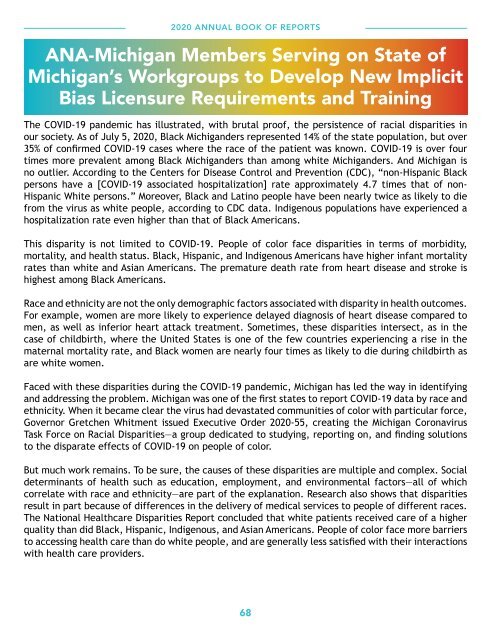ANA-Michigan - 2020 Annual Book of Reports
You also want an ePaper? Increase the reach of your titles
YUMPU automatically turns print PDFs into web optimized ePapers that Google loves.
<strong>2020</strong> ANNUAL BOOK OF REPORTS<br />
<strong>ANA</strong>-<strong>Michigan</strong> Members Serving on State <strong>of</strong><br />
<strong>Michigan</strong>’s Workgroups to Develop New Implicit<br />
Bias Licensure Requirements and Training<br />
The COVID-19 pandemic has illustrated, with brutal pro<strong>of</strong>, the persistence <strong>of</strong> racial disparities in<br />
our society. As <strong>of</strong> July 5, <strong>2020</strong>, Black <strong>Michigan</strong>ders represented 14% <strong>of</strong> the state population, but over<br />
35% <strong>of</strong> confirmed COVID-19 cases where the race <strong>of</strong> the patient was known. COVID-19 is over four<br />
times more prevalent among Black <strong>Michigan</strong>ders than among white <strong>Michigan</strong>ders. And <strong>Michigan</strong> is<br />
no outlier. According to the Centers for Disease Control and Prevention (CDC), “non-Hispanic Black<br />
persons have a [COVID-19 associated hospitalization] rate approximately 4.7 times that <strong>of</strong> non-<br />
Hispanic White persons.” Moreover, Black and Latino people have been nearly twice as likely to die<br />
from the virus as white people, according to CDC data. Indigenous populations have experienced a<br />
hospitalization rate even higher than that <strong>of</strong> Black Americans.<br />
This disparity is not limited to COVID-19. People <strong>of</strong> color face disparities in terms <strong>of</strong> morbidity,<br />
mortality, and health status. Black, Hispanic, and Indigenous Americans have higher infant mortality<br />
rates than white and Asian Americans. The premature death rate from heart disease and stroke is<br />
highest among Black Americans.<br />
Race and ethnicity are not the only demographic factors associated with disparity in health outcomes.<br />
For example, women are more likely to experience delayed diagnosis <strong>of</strong> heart disease compared to<br />
men, as well as inferior heart attack treatment. Sometimes, these disparities intersect, as in the<br />
case <strong>of</strong> childbirth, where the United States is one <strong>of</strong> the few countries experiencing a rise in the<br />
maternal mortality rate, and Black women are nearly four times as likely to die during childbirth as<br />
are white women.<br />
Faced with these disparities during the COVID-19 pandemic, <strong>Michigan</strong> has led the way in identifying<br />
and addressing the problem. <strong>Michigan</strong> was one <strong>of</strong> the first states to report COVID-19 data by race and<br />
ethnicity. When it became clear the virus had devastated communities <strong>of</strong> color with particular force,<br />
Governor Gretchen Whitment issued Executive Order <strong>2020</strong>-55, creating the <strong>Michigan</strong> Coronavirus<br />
Task Force on Racial Disparities—a group dedicated to studying, reporting on, and finding solutions<br />
to the disparate effects <strong>of</strong> COVID-19 on people <strong>of</strong> color.<br />
But much work remains. To be sure, the causes <strong>of</strong> these disparities are multiple and complex. Social<br />
determinants <strong>of</strong> health such as education, employment, and environmental factors—all <strong>of</strong> which<br />
correlate with race and ethnicity—are part <strong>of</strong> the explanation. Research also shows that disparities<br />
result in part because <strong>of</strong> differences in the delivery <strong>of</strong> medical services to people <strong>of</strong> different races.<br />
The National Healthcare Disparities Report concluded that white patients received care <strong>of</strong> a higher<br />
quality than did Black, Hispanic, Indigenous, and Asian Americans. People <strong>of</strong> color face more barriers<br />
to accessing health care than do white people, and are generally less satisfied with their interactions<br />
with health care providers.<br />
68

















